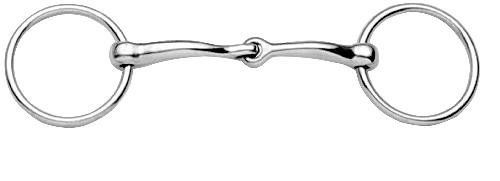Have you ever looked at a snaffle bit and wondered how it fits into a horse’s mouth and what effect it has when you pull on it? Snaffle bits are generally considered to be one of the kindest bits you can use, and that may be the case in the right hands but most riders have never considered the pain they can inflict when they use a snaffle.
There are two problems with the snaffle bit, the first is the design, the actual biomechanics of it, and the second is the ego of the person using one. Let’s start by thinking about what happens inside the horse’s mouth when the reins are picked up on a snaffle bit:
The apex of the bars in a horse’s mouth are only about an inch and a half apart. The bit itself is about five inches wide so that the rings sit outside the fleshy part of the horse’s mouth (lips). People sometimes want a wider snaffle bit, ironically, out of concern the rings might pinch the lips. Some owners have never put their hands inside their horse’s mouth to feel around, but I recommend you do that at least with your thumb or finger to get a feel for the bars. Most snaffles have an elbow joint in the middle, although some may have a French link and others may be straight through bit (like a Mullen).
The most common snaffles are the elbow or French link type. When you pick up on two reins the bit will be pulled back towards you creating a sharp angle that pushes into the roof of the horse’s mouth while the rings are pulled closer together in a nut cracker action on the bars of the horse’s mouth. To find relief from this very painful situation the horse will first gape its mouth, to create space, then raise its head to try to realign the bit so that pointed part is aimed along its tongue towards the front teeth while accepting more pressure on the back teeth and off the fleshy part of the bars (gums).
The human’s response is usually a progression, first to pull harder, then use a martingale or some other form of tie-down and then to wrap a cavesson around the horse’s mouth to stop it from finding relief from the pain inflicted. If these solutions don’t work the rider will get, a bigger hammer, a bit that inflicts more pain, a twisted wire snaffle or go to a leverage bit. At some level, hopefully, the rider may discover that they themselves are the cause of all the problems. They can simply stop pulling and learn to give back to the horse. The horse will learn far more from a release of pressure than by attempts to control it and constrict its movements.
In the end, the snaffle bit is a communication device that helps your horse to understand directional changes, principally, by picking up on one side or the other of the mouth. Horses are very sensitive creatures and one of the most sensitive parts of their bodies, like humans, is their mouth. A light touch of a rein can be felt long before the slack is taken out. The rings of the bit are not intended to provide signal, they are intended to ensure the horse doesn’t allow the bit to slide through their mouths. The bit itself, while not a perfect design can be used in a far more humane way than it typically is. To learn more, contact us and book a lesson at your facility.

